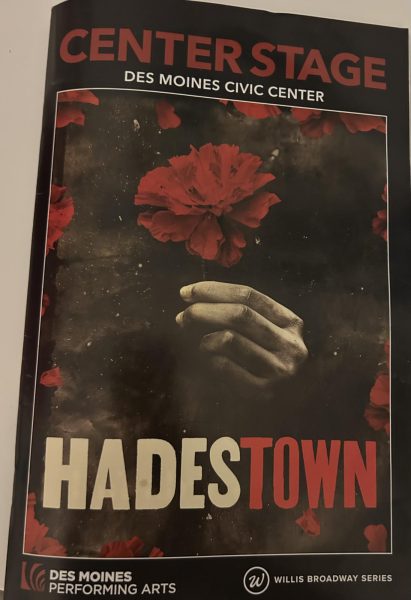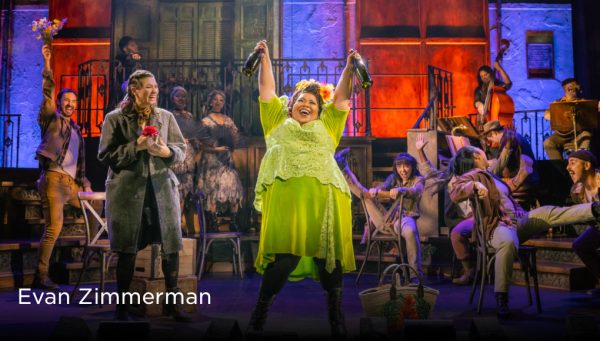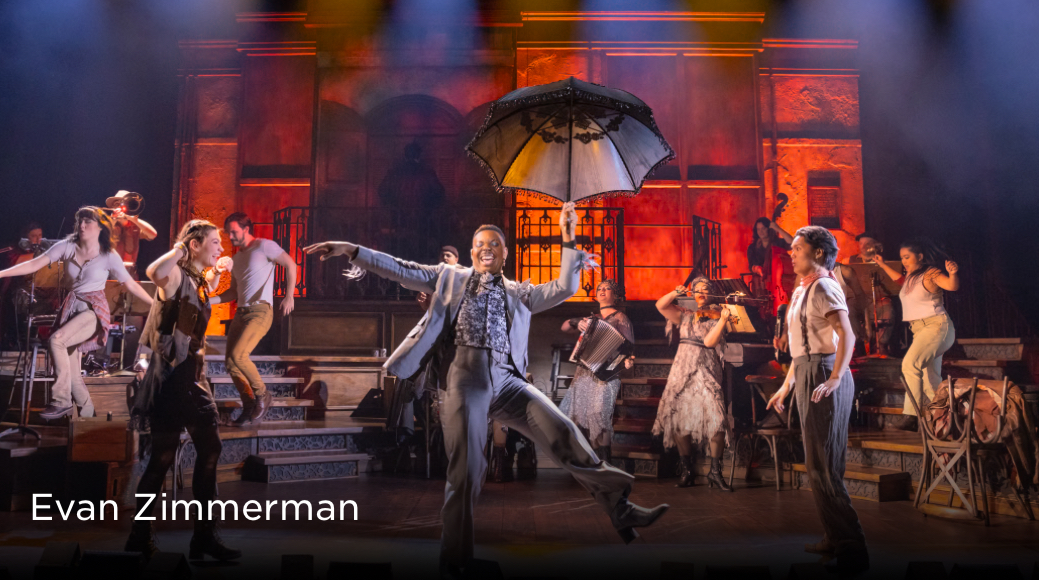As part of their Willis Broadway series, the Des Moines Civic Center welcomed Broadway’s Hadestown to the stage from April 11th-13th. The musical received yet-again glowing reviews, further validating its success that began at the Civic Center in March 2022. The musical made its debut in 2006 in a small production in Vermont and has since become a Broadway hit across the world. Combining classical Greek mythology with catchy jazz and modern folk music, Hadestown will certainly go down in history as a Broadway favorite.

Des Moines Civic Center (Allison Hunnicutt)
Hadestown puts its own spin on the Greek myths and stories of Orpheus, Eurydice, Hades, and Persephone. The musical is narrated by Hermes–the Greek messenger god–who is portrayed as a flamboyant and animated character, remembered by his bedazzled silver suit, a shiny top hat, and a sparkly cane. The musical opens with a trombone solo and Hermes singing the iconic line, “Once upon a time there was a railroad line…it was the Road to Hell.” In Greek mythology, the gods live in a mystical setting of Greece known as Mount Olympus. However, Hadestown takes on a modern interpretation, as the entire musical is set on Earth. While the Hadestown characters’ backgrounds and stories align relatively well with those told in the Greek myths, the characters don’t seem to have otherworldly abilities. The “railroad line” is alluding to the journey to the Underworld. However, the Underworld isn’t literally Hell as depicted in Greek mythology. Rather, Hadestown introduces the Underworld as–well–Hadestown: a town ruled by the Greek god Hades.
In Hermes’ opening song “Road to Hell,” he also introduces Orpheus, a young boy who is the son of a Muse and is characterized by his singing and playing of the lyre. In the Greek myth of Orpheus, the lyre is a stringed instrument associated with the Muses; however, in Hadestown, Orpheus plays a classic guitar. Orpheus then meets Eurydice, a young, poor girl who is struggling to survive. During his first interaction with her, Hermes advises Orpheus, “don’t come on too strong.” Orpheus rebelliously struts over to Eurydice and asks, “Come home with me.” And this marks the beginning of their love story, against all odds.

Orpheus and Eurydice’s story is intertwined with the myth of the marriage between Hades and Persephone. Persephone is the daughter of Demeter: the goddess of agriculture and fertility. During half of the year, Persephone lives with her husband down in Hadestown “where the sun never shines.” During the latter half of the year, she lives with her mother, where she picks flowers and “makes the sun shine brighter.” There is an interesting analysis to be made about the relationship between the dark, mysterious Hades and the bright, confident Persephone. Their marriage is not one without complications; Hadestown contrasts their two vastly different personalities through Persephone’s constant criticism of Hades and his so-called “gilded cage,” around which he instructs his captive, unpaid workers to build a wall with stones from the legendary River Styx.
Throughout the musical, Hades is frequently on stage overseeing his laborers, firstly and most notably in the song “Chant”–one of my favorite songs in the musical. Hades is placed on a pedestal and his workers pace around him, making robotic arm movements and chanting “low, keep your head, keep your head low.” Hadestown is a dark, intimidating place, and eventually a young girl falls into Hades’ trap. That young girl is Eurydice, and the two Greek myths begin to weave together, telling a story of love, hope, greed, and despair.
The staging, costumes, music, and other theatrical elements make Hadestown unforgettable. The band is actually on stage as opposed to in the pit, where the musicians with their instruments form a semicircle around the perimeter of the stage. The band interacts with both the audience and the characters, making the musical component of the performance engaging and unique. The Hadestown Soundtrack is one of the best I’ve heard; the songs balance catchy beats with passionate solos with intense rhythms. To add to the performance, the costumes perfectly reflect the essence of the characters. For example, Hades wears a black suit with dark sunglasses and has a chilling deep voice.
Hadestown is an entertaining story of Greek mythology with a modern twist. The soundtrack, staging, costumes, and diverse characters make the show a truly unique experience. Hermes preached in “The Road to Hell, “It’s a sad song, its a tragedy!” This is undeniably accurate, but it is also a production that leaves the audience on the edges of their seats and humming to the soundtrack on the drive home.


